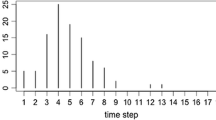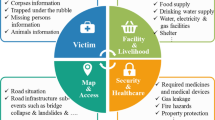Abstract
Volunteered geographic information (VGI) is the result of activities where individuals, supported by enabling technologies, behave like physical sensors by harvesting and organizing georeferenced content, usually in their surroundings. Both researchers and organizations have recognized the value of VGI content, however this content is typically heterogeneous in quality and spatial coverage. As a consequence, in order for applications to benefit from it, its quality and reliability need to be assessed in advance. This may not be easy since, typically, it is unknown how the process of collecting and organizing the VGI content has been conducted and by whom. In the literature, various proposals focus on an indirect process of quality assessment based on reputation scores. Following this perspective, the present paper provides as main contributions: (i) a multi-layer architecture for VGI which supports a process of reputation evaluation; (ii) a new comprehensive model for computing reputation scores for both VGI data and contributors, based on direct and indirect evaluations expressed by users, and including the concept of data aging; (iii) a variety of experiments evaluating the accuracy of the model. Finally, the relevance of adopting this framework is discussed via an applicative scenario for recommending tourist itineraries.









Similar content being viewed by others
Notes
Hereafter, we use the term reputation score, or simply score, in an interchangeable way to denote either the concept or its value, based on the context.
The features in user profile can also be analyzed by machine learning techniques in order to detect fake profiles or even multiple registrations of the same user, as proposed in Xiao et al. [21]. Then, fake profiles can be disabled or submitted to human checking.
Rise of the citizen scientist, http://www.nature.com/news/rise-of-the-citizen-scientist-1.18192
References
Aroyo L, Welty C (2013) Crowd truth: harnessing disagreement in crowdsourcing a relation extraction gold standard. WebSci2013 ACM 2013
Bishr M, Kuhn W (2013) Trust and reputation models for quality assessment of human sensor observations. In: Tenbrink T, Stell J, Galton A, Wood Z (eds) Spatial information theory: 11th international conference, COSIT 2013, Scarborough, UK, Proceedings. Springer International Publishing, Cham, pp 53–73. https://doi.org/10.1007/978-3-319-01790-7_4
Bordogna G, Carrara P, Criscuolo L, Pepe M, Rampini A (2014) A linguistic decision making approach to assess the quality of volunteer geographic information for citizen science. Inf Sci 258:312–327. https://doi.org/10.1016/j.ins.2013.07.013
Boulekrouche B, Jabeur N, Alimazighi Z (2016) Toward integrating grid and cloud-based concepts for an enhanced deployment of spatial data warehouses in cyber-physical system applications. J Ambient Intell Human Comput 7(4):475–487. https://doi.org/10.1007/s12652-016-0376-1
Brilhante IR, Macedo JA, Nardini FM, Perego R, Renso C (2015) On planning sightseeing tours with Tripbuilder. Inf Process Manag 51(2):1–15. https://doi.org/10.1016/j.ipm.2014.10.003
Brovelli MA, Minghini M, Zamboni G (2016) Public participation in GIS via mobile applications. ISPRS J Photogramm Remote Sens 114:306–315. https://doi.org/10.1016/j.isprsjprs.2015.04.002
D’Antonio F, Fogliaroni P, Kauppinen T (2014) VGI edit history reveals data trustworthiness and user reputation. In: 17th AGILE international conference on geographic information Science (Short Paper)
Dorn H, Törnros T, Zipf A (2015) Quality evaluation of VGI using authoritative data—a comparison with land use data in southern Germany. ISPRS Int J Geo-Inf 4(3):1657–1671
Goodchild MF (2007) Citizens as sensors: the world of volunteered geography. GeoJournal 69(4):211–221
Goodchild MF, Li L (2012) Assuring the quality of volunteered geographic information. Spat Stat 1:110–120. https://doi.org/10.1016/j.spasta.2012.03.002
Guo B, Wang Z, Yu Z, Wang Y, Yen NY, Huang R, Zhou X (2015) Mobile crowd sensing and computing: the review of an emerging human-powered sensing paradigm. ACM Comput Surv 48(1):7:1–7:31. https://doi.org/10.1145/2794400
Jokar AJ, Mooney P, Zipf A, Schauss A (2015) Quality assessment of the contributed land use information from openstreetmap versus authoritative datasets. In: OpenStreetMap in GIScience. Springer, pp 37–58
Jung JJ (2017) Computational collective intelligence with big data: challenges and opportunities. Fut Gener Comput Syst 66 (Supplement C):87–88. https://doi.org/10.1016/j.future.2016.08.021
Keßler C, Trame J, Kauppinen T (2011) Tracking editing processes in volunteered geographic information: the case of openstreetmap. Identifying objects, processes and events in spatio-temporally distributed data (IOPE), workshop at conference on spatial information theory, p 12
Mooney P, Corcoran P, Ciepluch B (2013) The potential for using volunteered geographic information in pervasive health computing applications. J Ambient Intell Human Comput 4(6):731–745. https://doi.org/10.1007/s12652-012-0149-4
Rodriguez MA, Egenhofer MJ (2003) Determining semantic similarity among entity classes from different ontologies. IEEE Trans Knowl Data Eng 15(2):442–456. https://doi.org/10.1109/TKDE.2003.1185844
Senaratne H, Mobasheri A, Loai Ali A, Capineri C, Haklay M (2016) A review of volunteered geographic information quality assessment methods. International Journal of Geographical Information Science https://doi.org/10.1080/13658816.2016.1189556
Sherchan W, Nepal S, Paris C (2013) A survey of trust in social networks. ACM Comput Surv 45 (4):47:1–47:33. https://doi.org/10.1145/2501654.2501661
Touya G, Antoniou V, Olteanu-Raimond AM, Van Damme MD (2017) Assessing crowdsourced poi quality: combining methods based on reference data, history, and spatial relations. ISPRS Int J Geo-Inf 6(3):1–29
Veregin H (1999) Data quality parameters. Geogr Inf Syst 1:177–189
Xiao C, Freeman DM, Hwa T (2015) Detecting clusters of fake accounts in online social networks. In: Proceedings of the 8th ACM workshop on artificial intelligence and security, ACM, New York, AISec ’15, pp 91–101. https://doi.org/10.1145/2808769.2808779
Yao J, Tan W, Nepal S, Chen S, Zhang J, Roure DD, Goble C (2015) Reputationnet: reputation-based service recommendation for e-science. IEEE Trans Serv Comput 8(3):439–452. https://doi.org/10.1109/TSC.2014.2364029
Ye B, Wang Y (2016) Crowdrec: Trust-aware worker recommendation in crowdsourcing environments. In: 2016 IEEE international conference on web services (ICWS), pp 1–8. https://doi.org/10.1109/ICWS.2016.10
Yu B, Singh MP (2002) An evidential model of distributed reputation management. In: Proceedings of the first international joint conference on autonomous agents and multiagent systems: Part 1. ACM, pp 294–301
Yu H, Shen Z, Leung C (2013) Bringing reputation-awareness into crowdsourcing. In: 2013 9th international conference on information, communications signal processing, pp 1–5. https://doi.org/10.1109/ICICS.2013.6782912
Yu H, Shen Z, Leung C, Miao C, Lesser VR (2013) A survey of multi-agent trust management systems. IEEE Access 1:35–50. https://doi.org/10.1109/ACCESS.2013.2259892
Zhao Y, Zhou X, Li G, Xing H (2016) A spatio-temporal VGI model considering trust-related information. ISPRS Int J Geo-Inf 5(2):10
Acknowledgements
The Authors are thanking the colleague Prof. Gianfranco Lamperti for his very valuable help in supporting the work described in this paper, and the former student Eng. Marco Gusmini for developing the first prototypes of the proposed solution.
Author information
Authors and Affiliations
Corresponding author
About this article
Cite this article
Jabeur, N., Karam, R., Melchiori, M. et al. A comprehensive reputation assessment framework for volunteered geographic information in crowdsensing applications. Pers Ubiquit Comput 23, 669–685 (2019). https://doi.org/10.1007/s00779-018-1122-9
Received:
Accepted:
Published:
Issue Date:
DOI: https://doi.org/10.1007/s00779-018-1122-9




